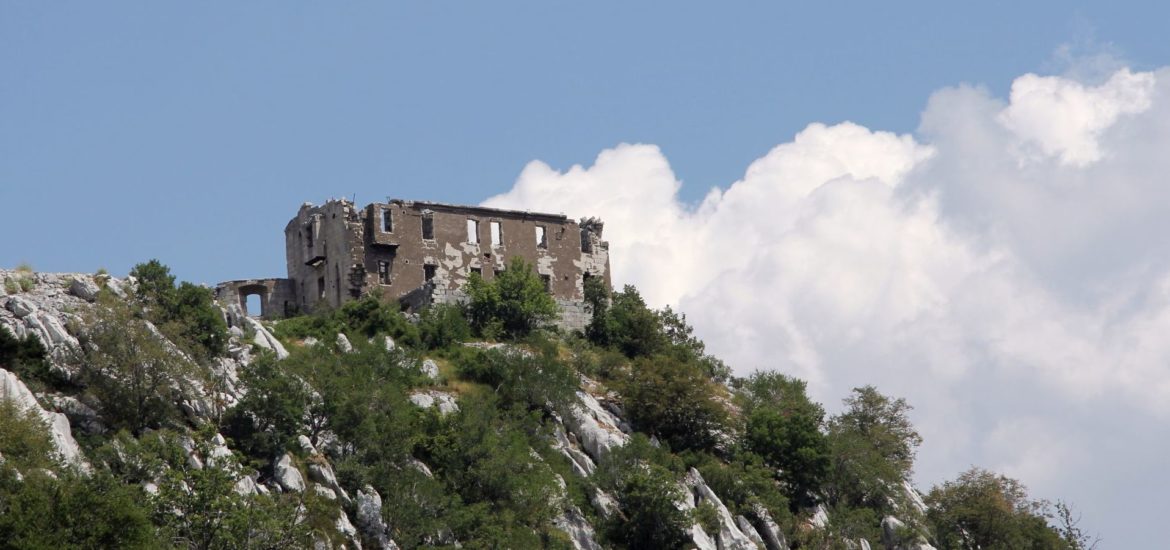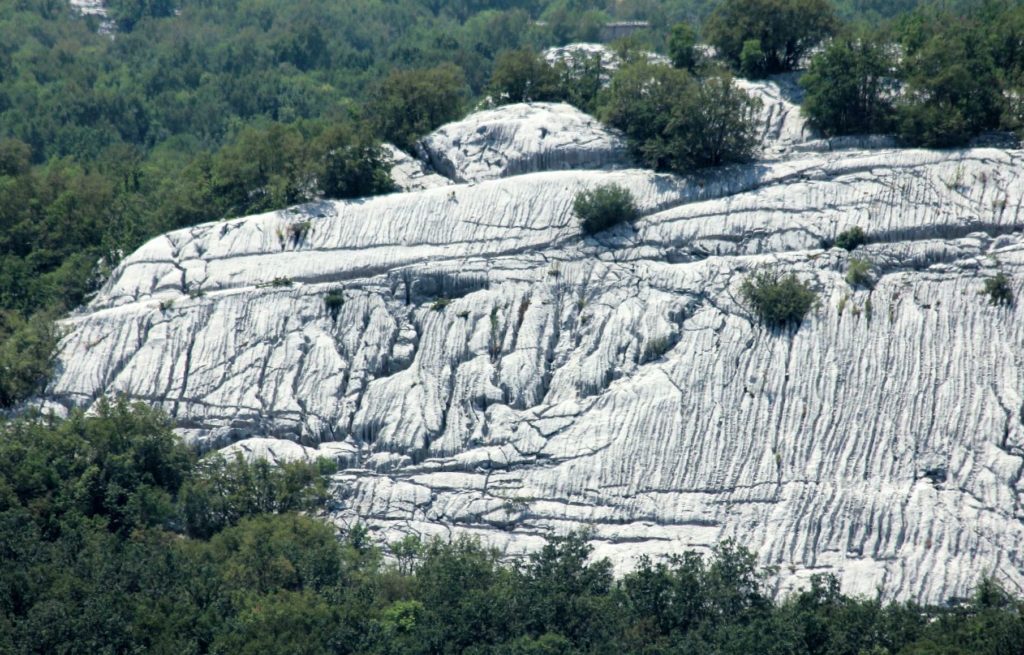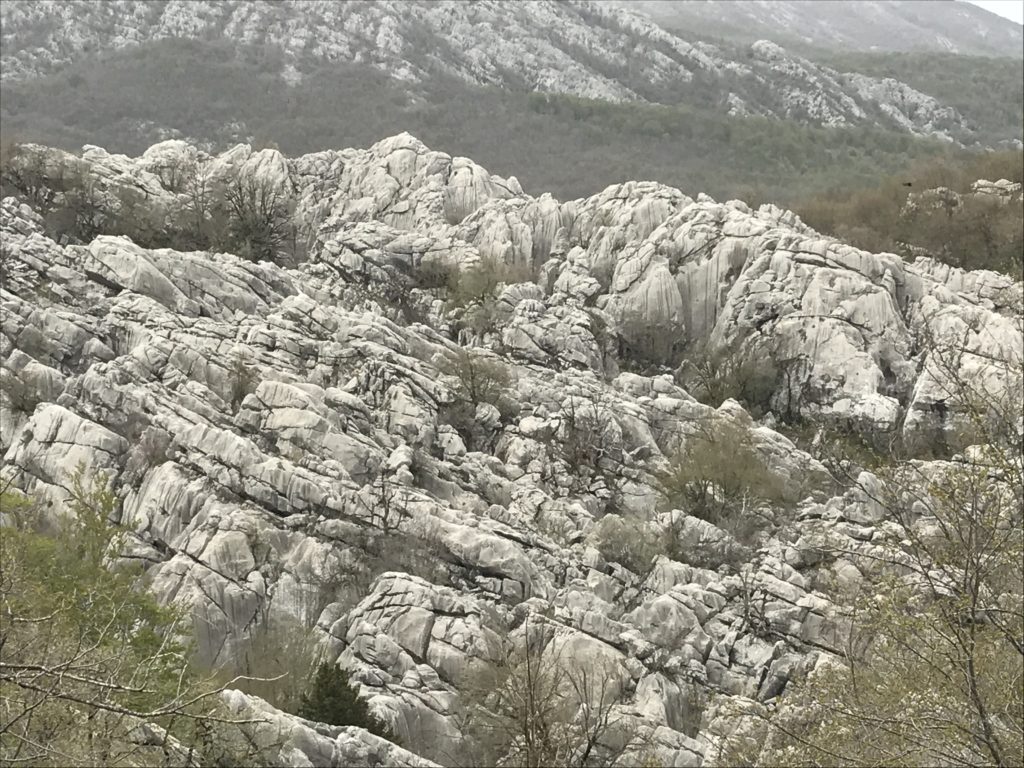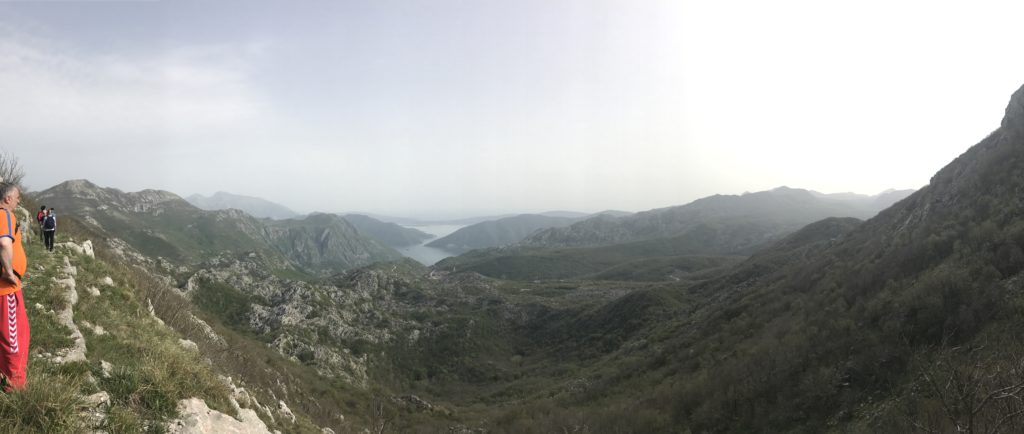Guest blogger: Nataša Đukanović
There is an expression in our language which describes the karst region we live in as – “ljuti kamen”. It is difficult to translate this into English or probably any other language, as it is impossible to use the literal translation – “angry stone”. It also applies to the hard life of the people who lived there, and even to their temper and nature. One of those stone landscapes is the area of Krivošije, which is situated on the eastern slopes of Mount Orjen, north-west from the Bay of Kotor, 1000 meters above sea level. By the way, this is the region with the greatest rainfall in Europe.
We have made a hiking tour from Crkvice, a village on the road from Risan to Nikšić (on the left side if you travel from Risan). When you reach the crossroads (luckily the only crossroad on this very narrow road, you can see it on the video below), there is a signage from where you can see an old Austro-Hungarian bakery from the end of the 19th century. According to some sources, one hundred years ago this region had more inhabitants than Podgorica or Nikšić. There were around fifteen shops, a bakery, a post office, a school and a hotel. According to Politika, the bakery was the biggest on the Balkans and the second biggest in Europe, after the one in Vienna. It produced 24 tons of bread per day for the military and their families. You can find the remains of the bakery, the hotel and the school, but – which is really amazing – there are also remains of a spa – a place where water was collected (as there are no natural springs here) and you can easily imagine how the soldiers took a bath there. Can you imagine how much water is needed for a garrison of 10.000 people? Yes, the spa is that big.
According to bokanews.me, where you can find wonderful photos from the Austrian archive, this place was the second biggest military base on the Adriatic.
When you see how this area looks like today, it is hard to imagine this was a place where the Austro-Hungarian army used to stay from the middle of the 19th century until the end of WWI, where the soldiers played tennis, watched the cinema and even had theatre shows.
Walking uphill from the “spa”, you see the remains of the Stražnik fortress, and on the next hill is the Kom fortress. Video by Ilija Perić:
After exploring both fortresses, we continued our hiking tour, circling behind the Kom fortress in the direction of two other fortresses called Ober and Under (local people just accepted the German names for these hills). And this is where the sea of stone became so overwhelming that I just couldn’t stop touching every stone I could reach. There are caves and notches so deep in the stones that it sometimes seems like a theatre curtain. After a couple of kilometers we found a cave we could enter; there was an astonishing organ-like structure inside, with a hole in the ceiling, so that the light went crazy (sorry, you have to go there and see it, no photo can show how fascinating it is).
We continued down the road made by the Austro-Hungarians, which was in a very good condition, having in mind that it had not been maintained and repaired for the last 100 years. The view on some areas stopped us many times:
The diversity of the track, from forests through grass fields to “angry stone”, from fortresses and high mountains to sea views, makes this trail one of the best I’ve ever hiked. It is about 15 kilometers long, with an elevation of around 400 meters. But you can also do a part of it, just don’t skip the part behind the Kom fortress where you can find the sea of stone.
And this is the track:






Hallo Marianne,
Heb je ook tips voor ons? We gaan dit jaar met alleen onze jongste zoon van 17 op vakantie, naar Montenegro. We gaan via Dresden, Boedaoest en de plitvice meren naar Montenegro: cultuur en wandelen dus:) Daarom zoeken wat (spannend – sportief) leuk vertier als ‘gebaar’ naar hem. Waar kun je bijv. (het beste) raften? En wat is nog meer leuk voot een 17-jarige?
Ja, raften is erg leuk. Je kunt bv. in Zabljak boeken of ook aan de grens met Bosnie, in Scepan Polje. Er zijn kortere tochten, maar je kunt ook een tweedaagse tour nemen.
Verder is kayaken erg populair, bv. op het Skadarmeer. Je kunt boeken bij de website boatmilica.com.
En tot slot denk ik aan kite-surfen op het grote strand “Velika Plaza” bij Ulcinj. Je kunt het daar ook leren, er zijn korte cursussen.
Veel plezier!
Groetjes,
Marianne
Hallo Marianne,
ik ben vorige week met mijn dochter in Montenegro op vakantie geweest . Een prachtig land. We hebben je verhalen gelezen en ze waren een soort reisgids voor ons. Het was helaas niet mogelijk om de Sedlo pas over te steken. Er lag nog teveel eis en sneeuw bovenin. Het is een mooi land om later nog eens met een camper te bezoeken.
Het is wel jammer dat er veel afval en restmaterialen zo langs de weg wordt gedumpt.
Maar een prachtig land met inderdaad om elke hoek weer een verrassing.
Groet.
Ton Dekker
Ik ben het helemaal met je eens. Inderdaad, jammer dat het afvalprobleem nog steeds niet opgelost is. Maar Montenegro is en blijft een prachtig land! Groetjes, Marianne
[…] Crkvice […]